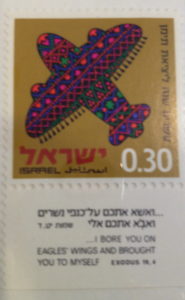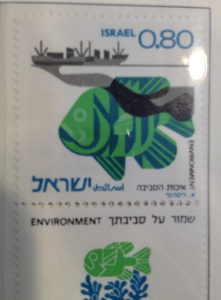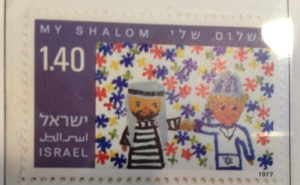Each year my Hebrew language students are captivated by something special that I bring to class- something that teaches them more than they ever imagined possible about Israel, its people, culture, history, geography and values. Something colorful and easily shared, that combines Hebrew, English and even a little Arabic into an easily understood “platform”.
Am I describing a new high-tech gadget or i-Phone app? No, what I bring to them is decidedly low-tech, even retro.
I bring them our Israeli stamp collection.
In this day of email and e-vites, when most people now pay bills online and when the majority of “snail mail” is stamp-free junk that goes straight to the recycling bin, postage stamps are something to which most of us, especially kids, seldom give a moments thought. The exception is when wedding or bar/bat mitzvah invitations are about to go out. For that occasion, the choice of stamps matters. We march off to the post office and peruse them carefully, seeking stamps that are beautiful, unique or that express something meaningful.
As my Hebrew students quickly discover, you can learn a great deal about a place from what it puts on its postage stamps. And the range of topics covered by the humble Israeli postage stamp is astonishing!
There are Israeli stamps that commemorate historical events and key figures- all the major Zionist leaders and founders of the State have been so honored. There are stamps that mark Jewish holidays, the arts, sports, technology, biblical stories and characters, places in Israel, nature and more, all in vivid detail. Biblical quotations appears frequently, lending additional shades of meaning and connection to Jewish texts.
I’d like to show you a few of my favorite stamps, and as you look at them, please consider the question I always ask my students to ponder:
What can we learn about Israel’s values and culture from this stamp?
Take a look at this colorful object. 
Is it an airplane? Or a colorful rug? Or maybe it is both.
This stamp was printed to mark the 20th anniversary of Operation Magic Carpet, the huge aliyah of Yemenite Jews that took place in 1949.
Note that “Israel” is written in Hebrew, English and Arabic, as it is on all stamps.
Below the stamp is a quotation from Exodus- “I bore you on eagles wings and brought you to myself”. It is said that this verse from Exodus was painted on the side of many of the planes used in Operation Magic Carpet, as a way of reassuring the Yemenite Jews who had never seen, much less flown, in an airplane.
The ingathering of Jews is a theme repeated in many other stamps as well.

Another favorite stamp, this time honoring the “jubilee” or 50th year of Magen David Adom, Israel’s emergency medical response service. The concept of the jubilee year or “yovel” dates back to the book of Leviticus (you can look it up!).The Talmudic quote “Whoever saves one life has saved an entire world” teaches how much Israeli society values human life.
The ancient Talmudic teaching is juxtaposed with the modern ambulance and image of cardiac monitoring, showing both the timelessness of the teaching and the intersection of old and new in every day Israeli life.
Another take on the value of human life, this stamp warns drivers to be careful. If you have ever driven in Israel or simply been a passenger on the road there, you know what Israeli drivers can be like. This stamp is truly a picture that is worth a thousand words.


Israeli stamps look outward as well as inward. This environmental stamp is from the 1970’s uses precise Hebrew to drive home the point that protecting the environment is each person’s responsibility. The line below the stamp does not say “Protect THE environment” but “Protect YOUR environment”. The grammar is very clear-it doesn’t mean the “collective” you, as in “you guys” but the individual “you”.

You don’t need to be Jewish or Israeli to be honored with an Israeli stamp. Raoul Wallenberg was a Swedish businessman and diplomat representing the Swedish government in Budapest, Hungary during World War II. By hiding Jews in buildings designated as Swedish territory and issuing passports that enabled Jews to flee he saved thousands of Hungarian Jews. He was later arrested and imprisoned by the Soviets and never heard from again.

U.S. president Harry Truman has his own Israeli stamp. Israel declared statehood at midnight on May 14, 1948. Eleven minutes later, the White House, under President Harry Truman, issued the following statement:
“This Government has been informed that a Jewish state has been proclaimed in Palestine, and recognition has been requested by the provisional government thereof. The United States recognizes the provisional government as the de facto authority of the State of Israel.”
Thus was the American president honored. The quote below the stamp from the Psalms attests to the respect Israelis felt toward him.
A special Israeli stamp was issued for the US bicentennial in 1976. More recently a stamp was issued remembering the victims of Sept. 11, 2001. These stamps underscore the special friendship and shared values between our two countries.
A sense of hope pervades many of many favorite stamps.

This one marks the 1976 Summer Olympic Games in Montreal. At the prior summer games in 1972 in Munich eleven Israeli athletes were kidnapped and killed. And yet, four years later, Israel anticipates the next Summer Games with this image of a graceful gymnast.
Another hopeful image, from a collection of children’s drawings about peace, “My Shalom”. The year was 1977, a time when Israel did not yet have a peace treaty with a single Arab country.
 This month Israel lost a great leader, Ariel Sharon, a former prime minister and one of the last of Israel’s founding generation. Countless articles and op-eds are recounting his life and assessing his legacy.
This month Israel lost a great leader, Ariel Sharon, a former prime minister and one of the last of Israel’s founding generation. Countless articles and op-eds are recounting his life and assessing his legacy.
Steve Hunegs, Executive Director of the JCRC, shares my love of Israeli stamps. He has written the following:
“As with Sally, I have a philatelic interest in Israel. Although, in my case, my predecessor Steve Silberfarb collected the stamps and “first day covers” which I enjoy viewing–so my access to the postage is somewhat derivative.
Taking a look at Steve’s shoe box of the first day covers I pick one randomly. It so happens my selection has great meeting and poignancy related to the passing of Prime Minister Sharon.
The first day cover is a picture from the aftermath of the Yom Kippur War dated October 29, 1973. The caption reads: “Egyptian and Israeli Officers Shake Hands While UN Observer Looks On.”
Taken about 24 days after the beginning of the war which Egypt and Syria began with its surprise attack on Israel, the Israelis and Egyptians are shaking hands due to the operational genius of Ariel Sharon. His amphibious assault across the Suez Canal put Israeli soldiers on the west side of the canal and encircled the Egyptian Third Army in Egypt proper.
Meanwhile, the initial success of the Egyptian surprise attack via their own amphibious attack left Egyptian forces on the east side of the canal which the Israelis had struggled to dislodge. The presence of Egyptian soldiers in Israeli Sinai was a measure of restoration of Egyptian military pride after the humiliation of the Six Day War.
In Abraham Rabinovich’s book–“The Yom Kippur War”, the author describes the assessment of Secretary of State Henry Kissinger (which was supported by Richard Nixon) that the commingling of the Israeli and Egyptian forces provided an opportunity to insist upon direct disengagement talks-military to military–between the Israelis and the Egyptians.
The Israelis had longed wished for talks without interlocutors with the Egyptians and the other neighboring states. The Arabs states had refused, not even wanting to raise the possibility of implying recognition of the sovereign Jewish state. Expecting resistance from Anwar Sadat, Kissinger received acquiescence. Rabinovich describes in his book Kissinger talking to Prime Minister Golda Meir and describing the “yes” answer as an outcome akin to miraculous.
Ultimately, the shaking of hands of Israeli and Egyptian staff officers led to the direct disengagement talks which separated the Israeli and Egyptian forces. This handshake led to a handshake of even more profound importance– the handshake of Anwar Sadat with Israel’s Prime Minster Menachem Begin at the former’s arrival in Israel in November, 1977.
Little did the designer of this October, 1973 first day cover realize he had captured a first step on a postcard towards the peace treaty between Egypt and Israel.“
Surely someday a postage stamp will be issued to honor Sharon’s memory. We can only wonder how Sharon, described by Yossi Klein Halevi as “a man of many incarnations”, will be commemorated in the tiny, low-tech, yet enduring medium of the postage stamp.

